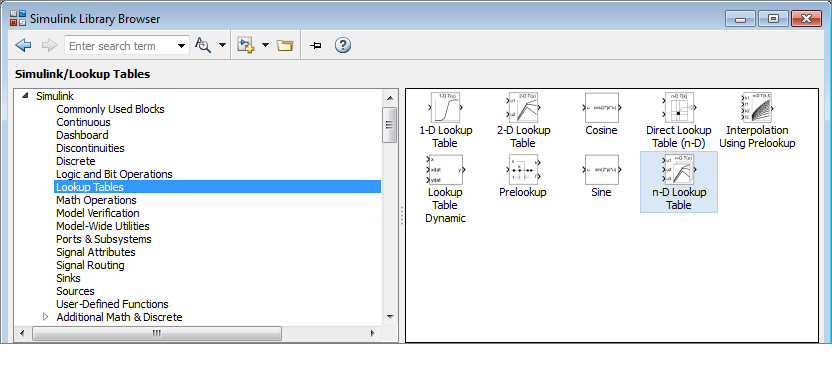Nonlinearity
Model nonlinearity with lookup tables, approximate mathematical functions by mapping
input values to output values
If you are new to modeling nonlinearity, first try using a lookup table block. Lookup table blocks use arrays of data to map input values to output values, approximating mathematical functions. To approximate a function in N variables, use the n-D Lookup Table block:
To manage the lookup tables in your environment, consider using the Lookup Table Editor. Watch How to Use the Lookup Table Editor (5min 9sec).

Blocks
| 1-D Lookup Table | Approximate one-dimensional function |
| 2-D Lookup Table | Approximate two-dimensional function |
| Direct Lookup Table (n-D) | Index into n-dimensional table to retrieve element, vector, or 2-D matrix |
| Interpolation Using Prelookup | Use precalculated index and fraction values to accelerate approximation of N-dimensional function |
| Lookup Table Dynamic | Approximate a one-dimensional function using dynamic table |
| n-D Lookup Table | Approximate n-dimensional function |
| Prelookup | Compute index and fraction for Interpolation Using Prelookup block |
| Sine, Cosine | Implement fixed-point sine or cosine wave using lookup table approach that exploits quarter wave symmetry |
Classes
Simulink.LookupTable | Store and share lookup table and breakpoint data, configure data for ASAP2 and AUTOSAR code generation |
Simulink.Breakpoint | Store and share data for a breakpoint set, configure the data for ASAP2 and AUTOSAR code generation |
Simulink.lookuptable.Evenspacing | Configure even spacing set data for lookup table object |
Simulink.lookuptable.Table | Configure table data for lookup table object |
Simulink.lookuptable.Breakpoint | Configure breakpoint set data for lookup table object |
Simulink.lookuptable.StructTypeInfo | Configure settings for structure type that lookup table object uses in the generated code |
Functions
lookupTableEditor | Start Lookup Table Editor (Since R2022a) |
Topics
About Lookup Tables
- About Lookup Table Blocks
A lookup table block uses an array of data to map input values to output values, approximating a mathematical function. - Anatomy of a Lookup Table
Breakpoint and table data are components of a lookup table. - Breakpoint and Table Size Features in Lookup Tables
Simulink® lookup tables have multiple breakpoint and table size features. - Guidelines for Choosing a Lookup Table
Select the best lookup table for your application. - Prelookup and Interpolation Blocks
Use Prelookup and Interpolation Using Prelookup blocks together. - Characteristics of Lookup Table Data
Comply with lookup table data requirements and represent discontinuous data. - Methods for Approximating Function Values
Set the method by which lookup table blocks approximate function values.
Work with Lookup Tables
- Use the Lookup Table Editor
Use the Lookup Table Editor to manage the lookup tables in your environment. - Edit Lookup Table Data with Lookup Table Spreadsheet
Work with lookup table objects with a lookup table spreadsheet. - Enter Breakpoints and Table Data
Specify breakpoint vectors and table data for lookup table blocks. - Visualize Data Through Plots
Use the Lookup Table Editor plots to visualize data in the spreadsheet. - Copy and Paste Lookup Table Data from Excel
Import data into a lookup table using copy and paste. - Generate Report of Lookup Table
Generate a report of one or more lookup tables in a model. - Import Lookup Table Data from MATLAB
You can import table and breakpoint data from variables in the MATLAB workspace by referencing them in the Table and Breakpoints tab of the dialog box. - Import Lookup Table Data from Excel Using readtable
Import data into a lookup table with thereadtablefunction. - Visualize Lookup Tables Visualized Through Lookup Table Control
Work with custom lookup tables from the Lookup Table Control. - Register Custom Lookup Table Blocks
You can use the Lookup Table Editor to register custom lookup table blocks that you have created. - Create a Logarithm Lookup Table
Work with lookup table blocks. - Optimize Generated Code for Lookup Table Blocks
Optimize generated code for lookup table blocks. - Row-Major Algorithm in Existing Models Containing Lookup Table Blocks
Update existing models to use row-major layout.
Update Lookup Tables from Previous Release
- Update Lookup Table Blocks to New Versions
Update existing models to use current versions of lookup table blocks.


